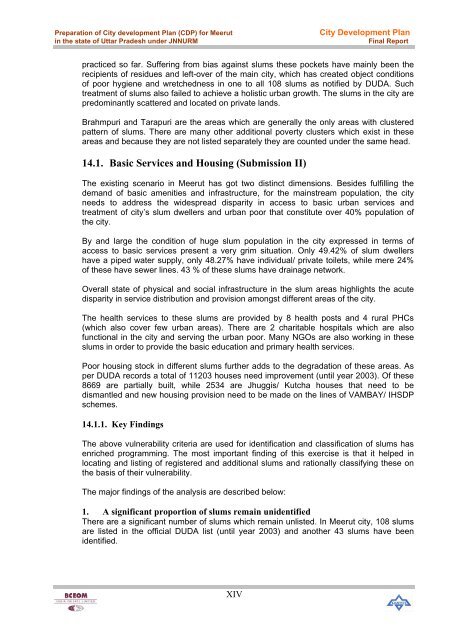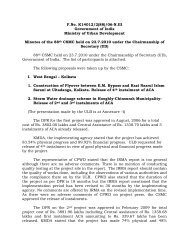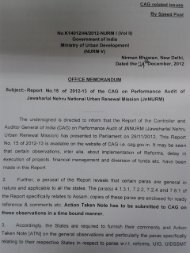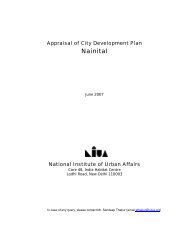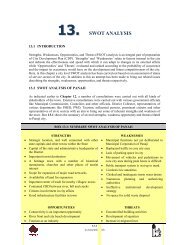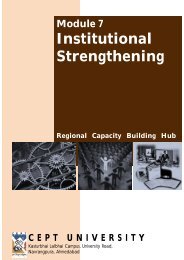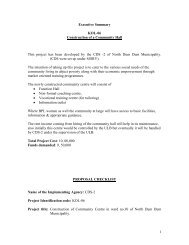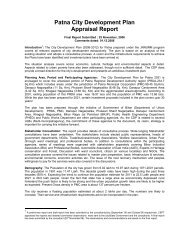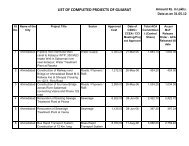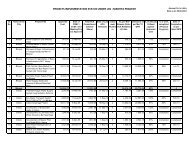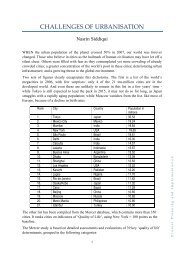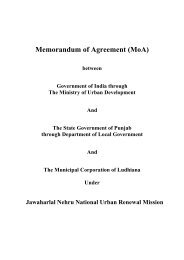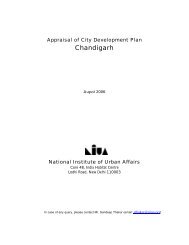CDP link - JnNURM
CDP link - JnNURM
CDP link - JnNURM
You also want an ePaper? Increase the reach of your titles
YUMPU automatically turns print PDFs into web optimized ePapers that Google loves.
Preparation of City development Plan (<strong>CDP</strong>) for Meerut<br />
in the state of Uttar Pradesh under JNNURM<br />
City Development Plan<br />
Final Report<br />
practiced so far. Suffering from bias against slums these pockets have mainly been the<br />
recipients of residues and left-over of the main city, which has created object conditions<br />
of poor hygiene and wretchedness in one to all 108 slums as notified by DUDA. Such<br />
treatment of slums also failed to achieve a holistic urban growth. The slums in the city are<br />
predominantly scattered and located on private lands.<br />
Brahmpuri and Tarapuri are the areas which are generally the only areas with clustered<br />
pattern of slums. There are many other additional poverty clusters which exist in these<br />
areas and because they are not listed separately they are counted under the same head.<br />
14.1. Basic Services and Housing (Submission II)<br />
The existing scenario in Meerut has got two distinct dimensions. Besides fulfilling the<br />
demand of basic amenities and infrastructure, for the mainstream population, the city<br />
needs to address the widespread disparity in access to basic urban services and<br />
treatment of city’s slum dwellers and urban poor that constitute over 40% population of<br />
the city.<br />
By and large the condition of huge slum population in the city expressed in terms of<br />
access to basic services present a very grim situation. Only 49.42% of slum dwellers<br />
have a piped water supply, only 48.27% have individual/ private toilets, while mere 24%<br />
of these have sewer lines. 43 % of these slums have drainage network.<br />
Overall state of physical and social infrastructure in the slum areas highlights the acute<br />
disparity in service distribution and provision amongst different areas of the city.<br />
The health services to these slums are provided by 8 health posts and 4 rural PHCs<br />
(which also cover few urban areas). There are 2 charitable hospitals which are also<br />
functional in the city and serving the urban poor. Many NGOs are also working in these<br />
slums in order to provide the basic education and primary health services.<br />
Poor housing stock in different slums further adds to the degradation of these areas. As<br />
per DUDA records a total of 11203 houses need improvement (until year 2003). Of these<br />
8669 are partially built, while 2534 are Jhuggis/ Kutcha houses that need to be<br />
dismantled and new housing provision need to be made on the lines of VAMBAY/ IHSDP<br />
schemes.<br />
14.1.1. Key Findings<br />
The above vulnerability criteria are used for identification and classification of slums has<br />
enriched programming. The most important finding of this exercise is that it helped in<br />
locating and listing of registered and additional slums and rationally classifying these on<br />
the basis of their vulnerability.<br />
The major findings of the analysis are described below:<br />
1. A significant proportion of slums remain unidentified<br />
There are a significant number of slums which remain unlisted. In Meerut city, 108 slums<br />
are listed in the official DUDA list (until year 2003) and another 43 slums have been<br />
identified.<br />
XIV


